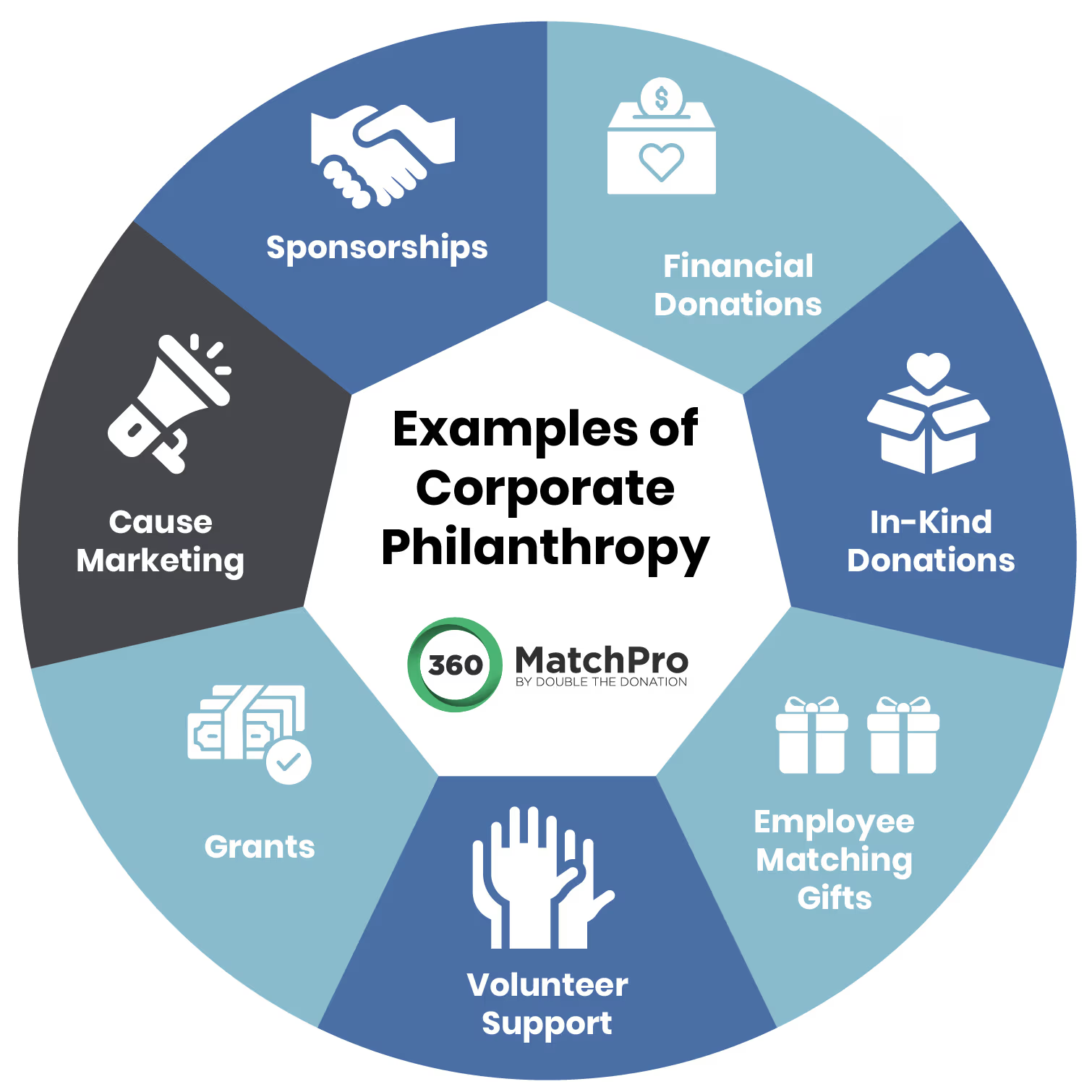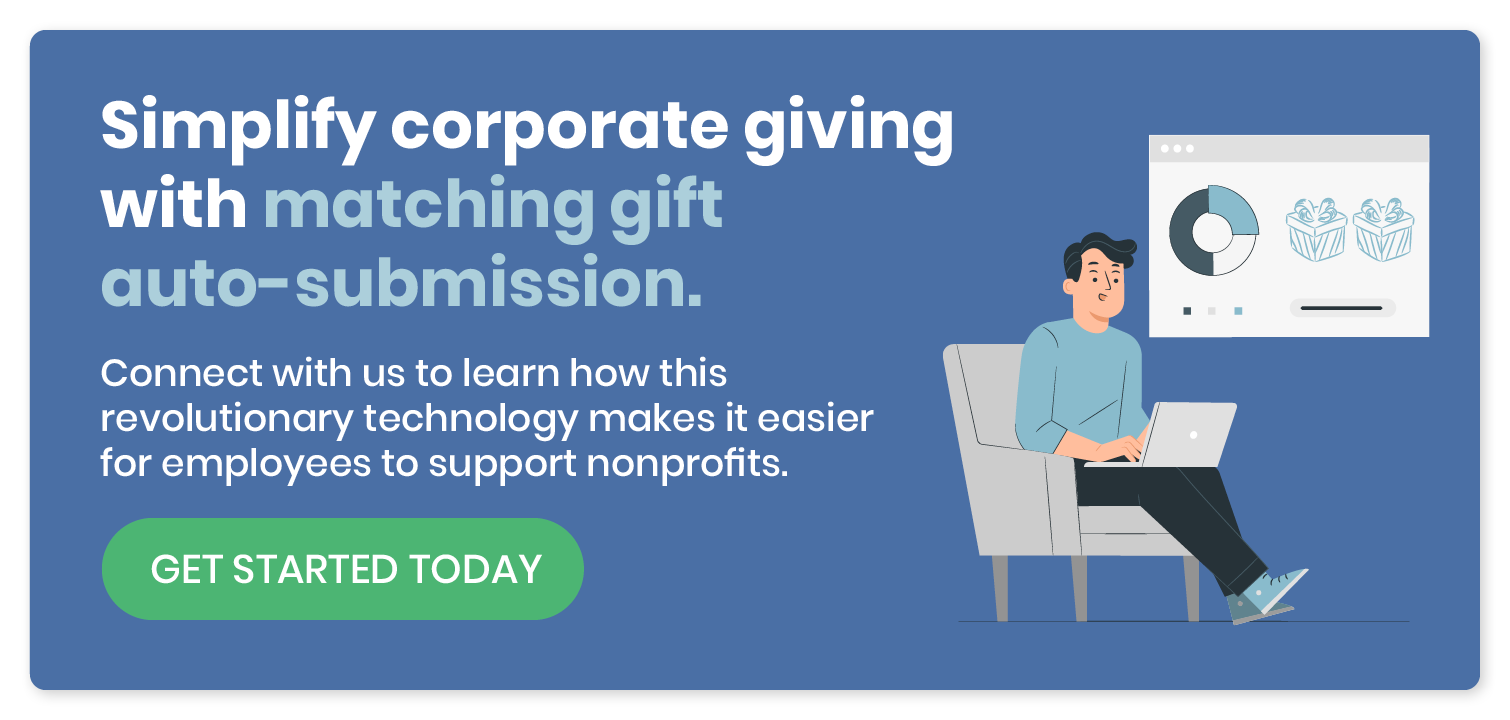7 Types of Corporate Philanthropy and How to Leverage Them
Businesses today are not just expected to generate profits; they are also expected to give back to their communities and support social and environmental causes. To accomplish this, businesses must first understand the array of charitable giving options available to them.
In this guide, we’ll explore the multifaceted landscape of corporate philanthropy, breaking down the various strategies companies can employ to make a positive impact on society. Whether you’re a seasoned corporate social responsibility (CSR) professional looking to refine your philanthropic initiatives or a business leader eager to embark on a journey of social responsibility, these insights will help you support charitable causes while strengthening your own brand and reputation.
What are the benefits of using different types of corporate philanthropy?
Taking a multifaceted approach to corporate philanthropy allows businesses to influence more than a single cause. Diversity in giving not only resonates with a broader range of stakeholders, employees, and customers but also addresses nonprofits’ evolving needs.
Additionally, businesses that rely on a single form of philanthropy may struggle if circumstances change. For example, if a business only focuses on matching gifts and faces financial difficulties, it may have to cut philanthropic contributions altogether. With multiple types of corporate philanthropy, you can provide long-term sustainable support to nonprofits in need.
7 Types of Corporate Philanthropy
Businesses can contribute to charitable causes and support their communities in several ways. Here are seven common forms of corporate philanthropy:

1. Financial Donations
Financial donations are perhaps the most common form of corporate philanthropy, with businesses giving $21.08 billion to charitable causes last year alone. If your business is interested in providing monetary contributions, you have several options, including:
- Direct cash donations: Make direct monetary contributions to nonprofits, either as one-time donations or through ongoing financial support.
- Employee charitable giving programs: Allow employees to allocate a percentage of their paychecks to charitable causes.
- Round-up programs: Implement round-up programs at checkout, giving customers the option to round their purchase up to the nearest dollar, with the additional amount donated to a nonprofit.
- Stock or asset donations: Consider providing nonprofits with long-term financial security through publicly traded stocks or bonds.
Before you make any significant financial contributions, review your company’s budget to identify funds or discretionary income that can be allocated to philanthropic purposes. Evaluate whether the business anticipates any major financial obligations, capital expenditures, or other financial commitments that may impact its ability to donate. Then, establish clear guidelines for philanthropic giving, including the percentage of profits or revenue that can be allocated to donations.
2. In-kind Donations
In-kind donations provide nonprofits with support in the form of tangible goods and services and can be a cost-effective way for businesses to get involved in corporate philanthropy. Plus, donating surplus or reusable items rather than disposing of them can align with a company’s sustainability goals.
Whether you choose to donate products, services, or assets, here are three tips to ensure your in-kind donations are used effectively:
- Understand nonprofit needs. Before making in-kind donations, reach out to the nonprofits you intend to support and get to know their specific needs. Consider factors like the populations they serve, their missions, and the programs that require urgent donations to ensure that your contributions are both relevant and impactful.
- Maintain transparency. Clearly define the terms and conditions of the donation, including logistical details like delivery, storage, and distribution. Regularly check in with the nonprofits to assess the impact of your donations and to address any concerns that may arise.
- Leverage employee engagement. Engage your employees in the process of selecting and delivering in-kind donations. For example, a bakery might hand-deliver an industrial stand mixer and surplus ingredients to a local food bank and walk nonprofit staff through a tutorial on how the device works.
When businesses donate in-kind contributions, such as goods, services, or equipment, to nonprofits, they may be eligible for tax deductions based on the fair market value of the donated items. Ensure that you receive the required documentation from the nonprofits you support, including receipts or appraisals, to substantiate the deduction.
3. Employee Matching Gifts
Under a matching gifts program, if an employee donates to a nonprofit and meets the company’s matching gift criteria, the company will financially match their contribution, typically at a 1:1 ratio.
Here’s how the process traditionally works:
- An employee makes a charitable donation to a nonprofit organization.
- The employee checks that their company offers a matching gift program and if the nonprofit is eligible for matching.
- If eligible, the employee initiates the matching gift process by submitting a request to their employer. This request often includes details about the donation, such as the amount, date, and the nonprofit’s information.
- The company’s CSR team or HR department reviews the employee’s submission to ensure it meets the established guidelines and criteria.
- If the donation qualifies, the company approves the application and processes a matching donation to the nonprofit.
Matching gift auto-submission streamlines this process and reduces the administrative burden on you and your employees, making it more convenient to participate. Made possible by integrating 360MatchPro with certain CSR software platforms, auto-submission identifies eligible donations, verifies requests, and initiates the matching gift process, so you don’t have to. For more information on how matching gift auto-submission works, watch this video:
To leverage matching gift auto-submission, ensure that your business has robust CSR software with the necessary matching gift auto-submission functionality in place. Next, reach out to your provider to inquire about the availability and feasibility of implementing an auto-submission feature for matching gift requests. Once confirmed, educate employees about this automated process and encourage them to participate in matching gift programs.
4. Volunteer Support
Volunteering for community service can be an effective team-building exercise for your business. The two most common forms of corporate volunteering are:
- Skills-based volunteer programs: Encourage employees to contribute their professional expertise and skills to help nonprofits address specific challenges. For example, marketing professionals might assist a nonprofit in developing a social media campaign, while IT specialists can help set up and maintain their computer systems.
- Corporate volunteer days or service projects: Corporate volunteer days or service projects are events businesses organize with their nonprofit partners in which employees come together to volunteer as a team for a specific cause or nonprofit organization. These programs typically take place on designated days and involve activities such as environmental cleanup, food packing for food banks, or building homes.
- Volunteer grants: Volunteer grants, also known as Dollars for Doers programs, are initiatives in which businesses financially match their employees’ volunteer hours. Employees who volunteer a certain number of hours or reach specific milestones with nonprofits can request that their employer make a charitable donation to the nonprofit on their behalf.
Consider implementing volunteer time off (VTO), which are days employees can take off specifically to volunteer. VTO helps to support employee volunteerism and reinforce your CSR initiatives. Establish a clear policy or program outlining the details of the initiative. This includes determining the number of hours or days of paid leave employees are eligible for, specifying how and when employees can request VTO, and outlining reporting or documentation requirements.
5. Grant-Making Foundations
Some corporations establish their own foundations or trusts to provide sustained support to communities and charitable causes. Your grant program depends on your company’s financial well-being and the needs of the nonprofits you serve. However, some common grants include:
- Program-specific grants: Program grants require nonprofits to submit proposals for specific projects your company will fund. Your foundation will have a specific mission, and program-specific grant proposals will articulate how the initiative they are seeking funding for aligns with that goal.
- Capital grants: Capital grants are used to support the acquisition, construction, renovation, or expansion of tangible assets like nonprofit facilities.
- General operating grants: These grants provide unrestricted funding to nonprofits, allowing them to allocate funds where they’re needed most, whether it’s for staff salaries, rent, utilities, or program delivery.
Keep in mind that establishing a foundation or trust has legal and administrative implications. Consult with an attorney, accountant, and financial advisor to help you set up your foundation and distribute grants.
6. Cause Marketing
Cause marketing is a strategic partnership between a business and a nonprofit organization in which both parties collaborate to promote a charitable cause while achieving their respective marketing and business objectives. The business typically pledges to donate a portion of its sales or profits, or engage in other promotional activities, to support the chosen cause. In turn, the business might see an increase in sales or an improved reputation, while the nonprofit receives a boost in brand awareness and donations.
To ensure your cause marketing campaign is a success, follow these steps:
- Select a nonprofit partner. Find a reputable nonprofit organization that is actively working on the chosen cause. Establish a partnership agreement outlining the terms of the collaboration, including the scope of the campaign, the duration, and the specific actions each party will take.
- Design a campaign. Create a cause marketing campaign that integrates the chosen cause into your ongoing marketing strategy. For instance, you could include the nonprofit’s branding in your marketing materials. Or, you might go as far as to design a product related to the cause, with a portion of the proceeds going to the nonprofit.
- Promote and measure. Launch the campaign and promote it across your marketing channels. Be transparent about the donation mechanism and how it benefits the cause.
Measure the cause marketing campaign’s impact on both your business and the nonprofit by collecting data on customer engagement, sales, and donations generated.
7. Corporate Sponsorships
Corporate sponsorships are mutually beneficial partnerships between businesses and charitable organizations or events. In most cases, the business will agree to financially support a nonprofit’s event or campaign in exchange for brand exposure.
Keep the following tips in mind as you engage in this type of corporate philanthropy:
- Align with your mission and values. Sponsoring a nonprofit that shares your business’s commitment to specific social or environmental causes creates an authentic and meaningful partnership. Ensure that the nonprofit’s goals and activities resonate with your employees, customers, and stakeholders to maximize the sponsorship’s impact.
- Clarify objectives and expectations. Determine the scope of your involvement, whether it’s financial support, in-kind donations, or employee volunteer opportunities, and define what you expect to receive in return. Having a transparent and well-documented arrangement helps both parties understand their roles and ensures a successful collaboration.
- Leverage engagement. Don’t just write a check and forget about it. Maximize the impact of your sponsorship by actively engaging with the event or cause. For instance, when sponsoring a virtual event, you might promote your involvement through various digital marketing channels like social media, email, and text to maximize visibility and connect with your target audience.
Maintaining open communication with nonprofit partners is crucial for facilitating transparency and trust. Gather feedback about their experience with your business and use these insights to improve your corporate philanthropy strategies going forward.
Tips for Implementing Different Types of Corporate Philanthropy
To make the most of various types of corporate philanthropy and ensure that your efforts have a meaningful impact, it’s important to have a well-thought-out strategy. Take these steps to maximize the benefits of corporate philanthropy:
Define Your Philanthropic Goals
A philanthropic mission statement outlines a company’s commitment to giving back and making a positive impact beyond its core business activities. It also serves as a guiding principle for the company’s charitable and social responsibility initiatives, helping to define the causes or areas of focus.
Work with your team to clarify your values and the social issues or causes that align with your corporate identity. Next, determine the scope of your philanthropic efforts, whether it’s focused on a specific community, a particular cause, or a broader global impact.
If you need assistance throughout this process, review examples from companies with well-established corporate philanthropy programs. For instance, the Coca-Cola Foundation has a strong mission statement that summarizes its plan to support local and global changemakers.
Develop a Corporate Philanthropy Policy
Create a corporate philanthropy policy to formalize your commitment to social responsibility and community engagement. This policy serves as a guiding framework that outlines your objectives, principles, and procedures related to charitable giving and volunteering. It should define the types of corporate philanthropy that you offer, provide clear guidelines for employee involvement, and detail the selection of charitable organizations, ensuring consistency and transparency in philanthropic efforts.
Engage Employees
Employees are the backbone of several types of corporate philanthropy. To ensure they feel empowered and engaged in your initiatives, create a dedicated CSR committee. This committee should be composed of volunteers from various departments and levels within your organization, ensuring diverse perspectives and ideas. Their role could be to identify charitable causes aligned with the company’s values and objectives, plan and execute fundraising events or donation drives, and oversee the distribution of resources to selected nonprofits.
Recognition is another essential element in engaging employees in corporate philanthropy. Acknowledge their participation through personalized thank-you notes or awards like “Philanthropist of the Month” to reinforce a culture of giving within your organization.
A Final Note About the Different Types of Corporate Philanthropy
As you embark on your philanthropic journey, remember that the true measure of success lies not only in the contributions that you make but also in the meaningful connections that you create throughout the process. So, take the knowledge gained from this guide and embark on a path of purpose-driven corporate philanthropy that leaves a lasting impact.
For more information on corporate philanthropy, check out these resources:
- A Smart Guide to Unlocking the Power of CSR Software in 2023. CSR software is the key to unlocking matching gift auto-submission and powering your different types of corporate philanthropy.
- 23+ Corporate Volunteer Ideas to Build A Better Community. Volunteering is a common type of corporate philanthropy. Explore over 20 innovative ways to organize volunteers for community service.
- Employee Giving Guide: How to Empower & Engage Employees. Employee giving empowers staff to make a personal impact on their communities. Learn how to start or optimize your existing program in this guide.





